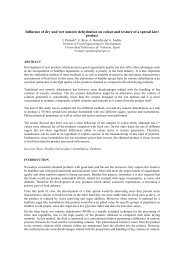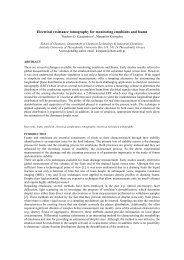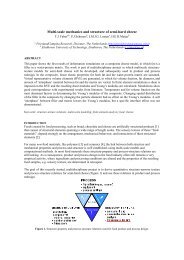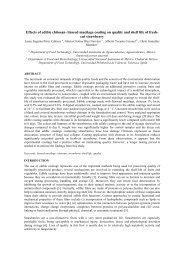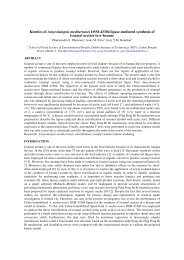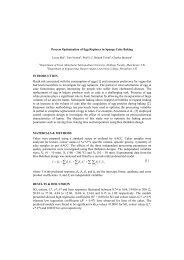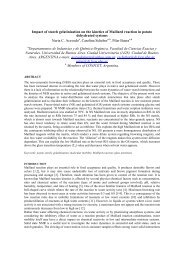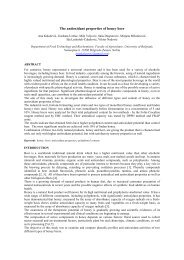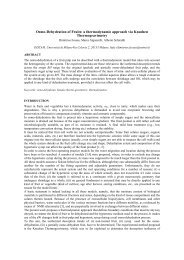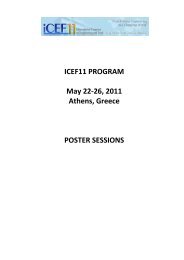Vitamin C Content of Freeze-Dried Tropical Fruits - 11th ...
Vitamin C Content of Freeze-Dried Tropical Fruits - 11th ...
Vitamin C Content of Freeze-Dried Tropical Fruits - 11th ...
You also want an ePaper? Increase the reach of your titles
YUMPU automatically turns print PDFs into web optimized ePapers that Google loves.
during freeze-drying because <strong>of</strong> the very low temperature and depletion <strong>of</strong> oxygen <strong>of</strong>fered by vacuum during<br />
process.<br />
CONCLUSION<br />
The vitamin C content <strong>of</strong> both fresh and freeze-dried guava, mango, papaya and pineapple was<br />
determined. Although losses have occurred during the process, the ascorbic acid content retained in the<br />
freeze-dried guava, mango, papaya and pineapple characterizes these products as a valuable source <strong>of</strong><br />
vitamin C. Concerning to papaya, the use <strong>of</strong> conventional freezing led to higher vitamin C loss when<br />
compared with the cryogenic freezing.<br />
ACKNOWLEDGEMENTS<br />
The authors are grateful to the Brazilian research supporting foundations FAPESP, Proc. 05/54624-9 and<br />
CNPq/PRONEX for their financial support.<br />
REFERENCES<br />
[1] Podsedek, A. 2007. Natural antioxidants and antioxidant capacity <strong>of</strong> Brassica vegetables: A review. LWT-Food<br />
Science and Technology, 40, 1-11.<br />
[2] Lee, S. K. & Kader, A. A. 2000. Preharvest and postharvest factors influencing vitamin C content <strong>of</strong> horticultural<br />
crops. Postharvest Biology and Technology, 20, 207-220.<br />
[3] Marques, L. G.; Ferreira, M. C. & Freire, J. T. 2007. <strong>Freeze</strong>-drying <strong>of</strong> acerola (Malpighia glabra L.). Chemical<br />
Engineering and Processing, 46, 451–457.<br />
[4] Marques, L. G.; Silveira, A. M. & Freire, J. T. 2006. <strong>Freeze</strong>-drying characteristics <strong>of</strong> tropical fruits. Drying<br />
Technology, 24(4), 457-463.<br />
[5] Lin, T. M.; Durance, T. D. & Scaman, C. H. 1998. Characterization <strong>of</strong> vacuum microwave, air and freeze-dried carrot<br />
slices. Food Research International, 31(2), 111-117.<br />
[6] Marfil, P. H. M.; Santos, E. M. & Telis, V. R. N. 2008. Ascorbic acid degradation kinetics in tomatoes at different<br />
drying conditions. LWT-Food Science and Technology, 1-6.<br />
[7] Ratti, C. 2001. Hot air and freeze-drying <strong>of</strong> high-values foods: A review. Journal Food Engineering, 49, 311-319.<br />
[8] Jayaraman, K. S., & Das Gupta, D. K. 1995. Drying <strong>of</strong> fruits and vegetables. In: Mujumdar, A. S. (Ed.). Handbook <strong>of</strong><br />
Industrial Drying. Inc. Marcel Dekker, New York, USA, 643-689.<br />
[9] Shadle, E. R.; Burns, E.E. & Talley, L. J. 1983. Forced air drying <strong>of</strong> partially freeze-dried compressed carrot bars.<br />
Journal <strong>of</strong> Food Science, 48(1), 193.<br />
[10] Yang, C. S. T. & Atallah, W. A. 1985. Effect <strong>of</strong> four drying methods on quality <strong>of</strong> intermediate moisture lowbush<br />
blueberries. Journal <strong>of</strong> Food Science, 1233-1237.<br />
[11] Benassi, M. T. & Antunes, A. J. 1988. A comparison <strong>of</strong> metaphosphoric and oxalic acids as extractants solutions for<br />
the determination <strong>of</strong> vitamin C in selected vegetables. Arq. Biol. Technol., 31(4), 507-513.<br />
[12] Nelson, J. W.; Barritt, B. H. & Wolford, E. R. 1972. Influence <strong>of</strong> location and cultivar on color and chemical<br />
composition <strong>of</strong> strawberry fruit. Wash. Agric. Exp. Stn. Tech. Bull, 74, 1-7.<br />
[13] Karel, M. & Nickerson, J. T. R. 1964. Effects <strong>of</strong> relative humidity, air and vacuum on browning <strong>of</strong> dehydrated<br />
orange juice. Food Technology.<br />
[14] Righetto, A. M. 2003. Caracterização físico-química e estabilidade de suco de acerola verde microencapsulado por<br />
atomização e li<strong>of</strong>ilização, Tese de Doutorado, FEA/UNICAMP, 176 p.<br />
[15] Chang, C.; Lin, H.; Chang, C.; Liu, Y. 2006. Comparisons on the antioxidant properties <strong>of</strong> fresh, freeze-dried and<br />
hot-air dried tomatoes. Journal <strong>of</strong> Food Engineering, 77, 478-485.<br />
[16] Leme, Jr., Fonseca, H. & Nogueira, J. N. 1973. Variação do teor de ácido ascórbico e beta-caroteno em cereja-dasantilhas<br />
(Malpighia punicifolia L.) li<strong>of</strong>ilizada. Archivos Latinoamericanos de Nutricion, 23(2), 207-215.<br />
[17] Roos, Y. H. 1993. Water activity and physical state effects on amorphous food stability. Journal <strong>of</strong> Food Processing<br />
and Preservation, 16, 433-447.<br />
[18] Papadakis, S. E. & Bahu, R. E. (1992). The sticky tissues <strong>of</strong> drying. Drying Technology, 10(4), 817-837.<br />
[19] Chuy, L. E. & Labuza, T. P. 1994. Caking and stickiness <strong>of</strong> dairy-based food powders as related to glass transition.<br />
Journal <strong>of</strong> Food Science, 59(1), 43-46.



